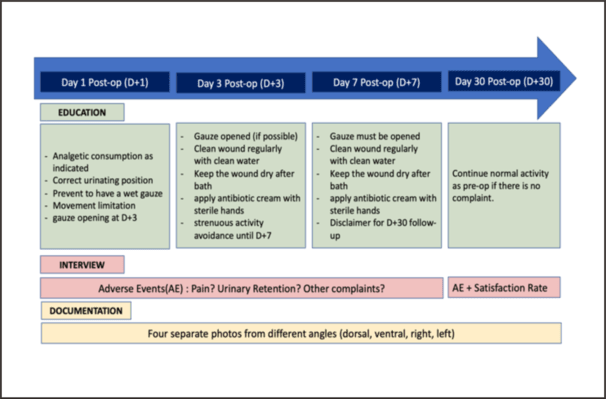THE ACCEPTABILITY OF TELEMEDICINE IN POST-MASS CHARITY CIRCUMCISION IN INDONESIA: A PILOT STUDY
DOI:
https://doi.org/10.14228/jprjournal.v10i1.348Keywords:
Charity, Mass, Circumcision, Telemedicine, AcceptabilityAbstract
Introduction: Charity circumcision is common in Indonesia. It is usually done by general practitioners or medical students under supervision. Procedures are often held on a mass scale and rarely followed with post-monitoring. We developed a telemedicine follow-up protocol to educate and address post-procedure complications. This pilot study evaluates the acceptability of telemedicine follow-up protocol for charity circumcision in Indonesia.
Method: Data were collected from operators and caregivers of children attending charity circumcision. The protocol consisted of text interviews (pain, urinary retention) and surgical sites' four-angle photographs (epithelialization, bleeding, infection, edema, and glans excoriation). The protocol was conducted two-way between caregivers and operators on days 1, 3, 7, and 30 after circumcision. The Ethics Committee of the Faculty of Medicine, Universitas Indonesia, has approved this study.
Result: Twenty-five boys with a mean age of 8.02±1.53 years old have similar pre-operative, operative, and postoperative protocols. Twenty-one caregivers completed four times follow-ups, one missed two times follow-ups, and three missed the last follow-up. Mild pain was the most reported complication, with 32% (8/25), 12% (3/25), 8% (2/24) incidence on days 1, 3, and 7, respectively. By the end of the follow-up, there were no persisting complications, and 80% (20/25) of boys showed complete epithelialization. All caregivers and most operators were satisfied with telemedicine for post-mass circumcision monitoring.
Conclusion: The telemedicine-based follow-up is acceptable and feasible to be applied in mass charity circumcision. This protocol is beneficial for monitoring the results and adverse events, therefore, should be routinely adopted in mass charity circumcision programs.
References
Weiss H, Larke N, Halperin D, Schenker I. Neonatal and child male circumcision: a global review [Internet]. Geneva: UNAIDS; 2010 [cited 16 January 2022]. Available from: https://www.who.int/hiv/pub/malecircumcision/neonatal_child_MC_UNAIDS.pdf
World Health Organization. Manual for male circumcision under local anaesthesia and HIV prevention services for adolescent boys and men. Geneva: WHO. 2018.
Malone P, Steinbrecher H. Medical aspects of male circumcision. BMJ. 2007;335(7631):1206-90. DOI: https://doi.org/10.1136/bmj.39385.382708.AD
Morris B, Wamai R, Henebeng E, et al. Estimation of country-specific and global prevalence of male circumcision. Popul Health Metr. 2016;14(4):1-13. DOI: https://doi.org/10.1186/s12963-016-0073-5
Kichloo A, Albosta M, Dettloff K, et al. Telemedicine, the current COVID-19 pandemic and the future: a narrative review and perspectives moving forward in the USA. Fam Med Comm Health. 2020;8(3). DOI: https://doi.org/10.1136/fmch-2020-000530
Joint Commission International. The optimal use of telehealth to deliver safe patient care. Quick Safety. 2020;55:1-4.
Wahezi SE, Kohan LR, Spektor B, et al. Telemedicine and current clinical practice trends in the COVID-19 pandemic. Best Pract Res Clin Anasesthesiol. 2021;35:307-19. DOI: https://doi.org/10.1016/j.bpa.2020.11.005
Silver L, Smith A, Johnson C, et al. Mobile connectivity in emerging economies. 2019; Available from: https://apo.org.au/node/224351
Özdemir E. Significantly increased complication risks with mass circumcisions. BJU. 1997;80:136-9. DOI: https://doi.org/10.1046/j.1464-410X.1997.00218.x
Asgari SA, Ghanaie MM, Simforoosh N, Kajbafzadeh A, Zare A. Acute urinary retention in children. J Urol. 2005;2(1):23-7.
Muoka O, Simpson A. Urinary Retention: An Uncommon Complication of Open Circumcision in the Paediatric Patients. Webmed Central Urology. 2012;3(7):WMC003596

Downloads
Published
Issue
Section
License
Copyright (c) 2023 Indri Aulia, Michelle Valeria, Nathaniel J. Zacharia, Bagus R. Amangku, M. Luthfi Prasetyo

This work is licensed under a Creative Commons Attribution-NonCommercial-NoDerivatives 4.0 International License.
Authors retain the copyright of the article and grant Jurnal Plastik Rekonstruksi the right of first publication with the work simultaneously licensed under a Creative Commons Attribution License. Articles opting for open access will be immediately available and permanently free for everyone to read, download and share from the time of publication. All open access articles are published under the terms of the Creative Commons Attribution-Non-commercial-NoDerivatives (CC BY-NC-ND) which allows readers to disseminate and reuse the article, as well as share and reuse of the scientific material. It does not permit commercial exploitation or the creation of derivative works without specific permission.













